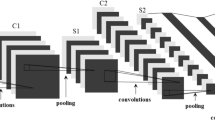Abstract
In this paper, an architecture based on memristors is proposed to implement image convolution computation in convolutional neural networks. This architecture could extract different features of input images when using different convolutional kernels. Bipolar memristors with threshold are employed in this work, which vary their conductance values under different voltages. Various kernels are needed to extract information of input images, while different kernels contain different weights. The memristances of bipolar memristors with threshold are convenient to be varied and kept, which make them suitable to act as the weights of kernels. The performances of the design are verified by simulation results.








Similar content being viewed by others
References
Chua LO (1971) Memristor-the missing circuit element. IEEE Trans Circuit Theory 18(5):507–519
Strukov DB, Snider GS, Stewartand DR, Williams RS (2008) The missing memristor found. Nature 534(7194):80–83
Adhikari SP, Kim H, Budhathoki R (2015) A circuit-based learning architecture for multilayer neural networks with memristor bridge synapses. IEEE Trans Circuits Syst I 62(1):215–223
Ebong IE, Mazumder P (2012) CMOS and memristor-based neural network design for position detection. Proc IEEE 100(6):2050–2060
Liu XY, Zeng ZG, Wen SP (2016) Implementation of memristive neural network with full-function Pavlov associative memory. IEEE Trans Circuits Syst I Regul Pap 63(9):1454–1463
Li B, Chen L, Li CD, Huang TW, He X, Li H, Chen YR (2014) STDP learning rule Based on memristor with STDP property. In: Proceedings of the international joint conference on neural networks
Shi L, Pei J, Deng N, Wang D, Deng L (2015) Development of a neuromorphic computing system. In: Proceedings of the IEDM,
Hu M, Strachan JP, Li Z, Grafals E, Davila N (2016) Dot-product engine for neuromorphic computing: programming 1T1M crossbar to accelerate matrix-vector multiplication. In: Proceedings of the 53rd annual design automation conference
Li B, Gu P, Shan Y, Wang Y, Chen YR, Yang HZ (2015) RRAM-based analog approximate computing. IEEE Trans Comput Aided Des Integr Circuits Syst 34(12):1905–1917
Ho Y, Huang GM, Li P (2011) Dynamical properties and design analysis for nonvolatile memristor memories. IEEE Trans Circuits Syst I 58(4):724–736
Knag P, Lu W, Zhang Z (2014) A native stochastic computing architecture enabled by memristors. IEEE Trans Nanotechnol 33(2):283–293
Hamdioui S, Xie L, Nguyen H, Taoui M (2015) Memristor based computation-in-memory architecture for data-intensive applications. In: Proceedings of the conference on design, automation and test in Europe
Li HH, Liu CC, Yan B, Yang CF, Song LH, Li Z, Chen YR (2015) Spiking-based matrix computation by leveraging memristor crossbar array. In: Proceedings of the IEEE symposium on computational intelligence for security and defense applications (CISDA)
Ahmad MS, Hyunsang H, Moongu J, Jeon M (2014) Neuromorphic character recognition system with two PCMO memristors as a synapse. IEEETrans Ind Electron 21(6):2933–2941
Nair MV, Dudek P (2015) Practical gradient-descent for memristive crossbars. In: Proceedings of the conference on memristive systems (MEMRISYS)
Alibart F, Zamanidoost E, Strukov DB (2013) Pattern classification by memristive crossbar circuits using ex situ and in situ training. Nat Commun 4(3):131–140
Abdel-Kader RF, Abuelenin SM (2015) Memristor model based on fuzzy window function. In: Proceedings of the fuzzy systems (FUZZ-IEEE)
Li B, Wang Y, Chen YR, Li HH, Yang HZ (2014) ICE: inline calibration for memristor crossbar-based computing engine. In: Proceedings of the conference on design, automation and test in Europe (DATE14)
Chen YR, Tian W, Li H, Wang XB, Zhu WZ (2010) PCMO device with high switching stability. IEEE Electron Device Lett 31(8):866–868
Lucia VG, Arturo B, Luigi F, Fortuna L (2015) Memristor-based adaptive coupling for consensus and synchronization. IEEE Trans Circuits Syst I 62(4):1175–1184
Wen SP, Zeng ZG, Chen MZQ, Huang TW (2016) Synchronization of switched neural networks with communication delays via the event-triggered method. IEEE Trans Neural Netw Learn Syst. doi:10.1109/TNNLS.2016.2580609
Wen GH, Yu WW, Li ZK, Yu XH, Cao JZ (2016) Neuro-adaptive consensus tracking of multiagent systems with a high-dimensional leader. IEEE Trans Cybern. doi:10.1109/TCYB.2016.2556002
Lu JQ, Ho D, Cao J, Kurths J (2011) Exponential synchronization of linearly coupled neural networks with impulsive disturbances. IEEE Trans Neural Netw 22(2):329–336
Wen SP, Zeng ZG, Huang TW, Meng QG, Yao W (2015) Lag synchronization of switched neural networks via neural activation function and applications in image encryption. IEEE Trans Neural Netw Learn Syst 26:1493–1502
Liu D, Li H, Wang D (2013) Neural-network-based zero-sum game for discrete-time nonlinear systems via iterative adaptive dynamic programming algorithm. Neurocomputing 110:92–100
Cheng L, Hou ZG, Tan M, Lin YZ, Zhang WJ (2013) Neural-network-based adaptive leader-following control for multiagent systems with uncertainties. Neurocomputing 110:92–100
Lecun Y, Bottou L, Bengio Y, Haffner P (1998) Gradient-based learning applied to document recognition. Proc IEEE 86(11):2278–2324
Lawrence S, Giles CL, Tsoi AC, Back AD (1997) Face recognition: a convolutional neural-network approach. IEEE Trans Neural Netw 8(1):98–113
Mian ML, King HL (2015) Malaysia traffic sign recognition with convolutional neural network. In: Proceedings of the DSP
Wang JH, Lu JJ, Chen WH, Wu XM (2015) Convolutional neural network for 3D object recognition based on RGB-D dataset. In: Proceedings of the ICLR
Krizhevsky A, Sutskever I, Hinton GE (2012) ImageNet classification with deep convolutional neural networks. In: Proceedings of the NIPS
Szegedy C, Liu W, Jia Y, Sermanet P, Reed S, Anguelov D, Erhan D, Vanhoucke V, Rabinovich A (2015) Going deeper with convolutions. In: Proceedings of the CVPR
Yuriy VP, Dalibor B, Massimiliano DV (2013) Reliable SPICE simulations of memristors, memcapacitors and meminductors, p 2717. arXiv:1307
Addison J, Wermter S, MacIntyre J (1999) Effectiveness of feature extraction in neural network architectures for novelty detection. In: Ninth international conference on artificial neural networks (ICANN 99)
Author information
Authors and Affiliations
Corresponding author
Rights and permissions
About this article
Cite this article
Zeng, X., Wen, S., Zeng, Z. et al. Design of memristor-based image convolution calculation in convolutional neural network. Neural Comput & Applic 30, 503–508 (2018). https://doi.org/10.1007/s00521-016-2700-2
Received:
Accepted:
Published:
Issue Date:
DOI: https://doi.org/10.1007/s00521-016-2700-2




